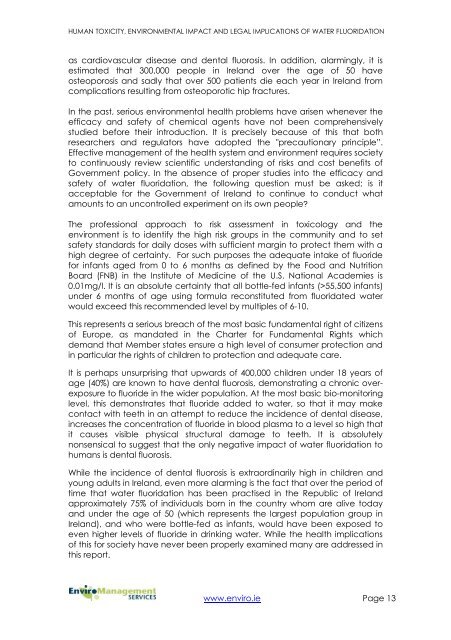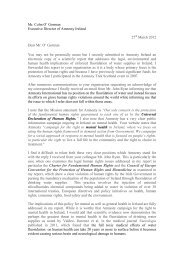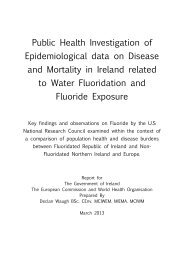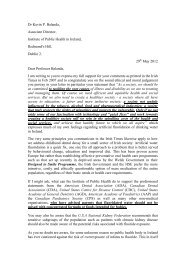Human Toxicity, Environmental Impact and Legal Implications of
Human Toxicity, Environmental Impact and Legal Implications of
Human Toxicity, Environmental Impact and Legal Implications of
You also want an ePaper? Increase the reach of your titles
YUMPU automatically turns print PDFs into web optimized ePapers that Google loves.
HUMAN TOXICITY, ENVIRONMENTAL IMPACT AND LEGAL IMPLICATIONS OF WATER FLUORIDATION<br />
as cardiovascular disease <strong>and</strong> dental fluorosis. In addition, alarmingly, it is<br />
estimated that 300,000 people in Irel<strong>and</strong> over the age <strong>of</strong> 50 have<br />
osteoporosis <strong>and</strong> sadly that over 500 patients die each year in Irel<strong>and</strong> from<br />
complications resulting from osteoporotic hip fractures.<br />
In the past, serious environmental health problems have arisen whenever the<br />
efficacy <strong>and</strong> safety <strong>of</strong> chemical agents have not been comprehensively<br />
studied before their introduction. It is precisely because <strong>of</strong> this that both<br />
researchers <strong>and</strong> regulators have adopted the "precautionary principle‖.<br />
Effective management <strong>of</strong> the health system <strong>and</strong> environment requires society<br />
to continuously review scientific underst<strong>and</strong>ing <strong>of</strong> risks <strong>and</strong> cost benefits <strong>of</strong><br />
Government policy. In the absence <strong>of</strong> proper studies into the efficacy <strong>and</strong><br />
safety <strong>of</strong> water fluoridation, the following question must be asked; is it<br />
acceptable for the Government <strong>of</strong> Irel<strong>and</strong> to continue to conduct what<br />
amounts to an uncontrolled experiment on its own people?<br />
The pr<strong>of</strong>essional approach to risk assessment in toxicology <strong>and</strong> the<br />
environment is to identify the high risk groups in the community <strong>and</strong> to set<br />
safety st<strong>and</strong>ards for daily doses with sufficient margin to protect them with a<br />
high degree <strong>of</strong> certainty. For such purposes the adequate intake <strong>of</strong> fluoride<br />
for infants aged from 0 to 6 months as defined by the Food <strong>and</strong> Nutrition<br />
Board (FNB) in the Institute <strong>of</strong> Medicine <strong>of</strong> the U.S. National Academies is<br />
0.01mg/l. It is an absolute certainty that all bottle-fed infants (>55,500 infants)<br />
under 6 months <strong>of</strong> age using formula reconstituted from fluoridated water<br />
would exceed this recommended level by multiples <strong>of</strong> 6-10.<br />
This represents a serious breach <strong>of</strong> the most basic fundamental right <strong>of</strong> citizens<br />
<strong>of</strong> Europe, as m<strong>and</strong>ated in the Charter for Fundamental Rights which<br />
dem<strong>and</strong> that Member states ensure a high level <strong>of</strong> consumer protection <strong>and</strong><br />
in particular the rights <strong>of</strong> children to protection <strong>and</strong> adequate care.<br />
It is perhaps unsurprising that upwards <strong>of</strong> 400,000 children under 18 years <strong>of</strong><br />
age (40%) are known to have dental fluorosis, demonstrating a chronic overexposure<br />
to fluoride in the wider population. At the most basic bio-monitoring<br />
level, this demonstrates that fluoride added to water, so that it may make<br />
contact with teeth in an attempt to reduce the incidence <strong>of</strong> dental disease,<br />
increases the concentration <strong>of</strong> fluoride in blood plasma to a level so high that<br />
it causes visible physical structural damage to teeth. It is absolutely<br />
nonsensical to suggest that the only negative impact <strong>of</strong> water fluoridation to<br />
humans is dental fluorosis.<br />
While the incidence <strong>of</strong> dental fluorosis is extraordinarily high in children <strong>and</strong><br />
young adults in Irel<strong>and</strong>, even more alarming is the fact that over the period <strong>of</strong><br />
time that water fluoridation has been practised in the Republic <strong>of</strong> Irel<strong>and</strong><br />
approximately 75% <strong>of</strong> individuals born in the country whom are alive today<br />
<strong>and</strong> under the age <strong>of</strong> 50 (which represents the largest population group in<br />
Irel<strong>and</strong>), <strong>and</strong> who were bottle-fed as infants, would have been exposed to<br />
even higher levels <strong>of</strong> fluoride in drinking water. While the health implications<br />
<strong>of</strong> this for society have never been properly examined many are addressed in<br />
this report.<br />
www.enviro.ie Page 13






